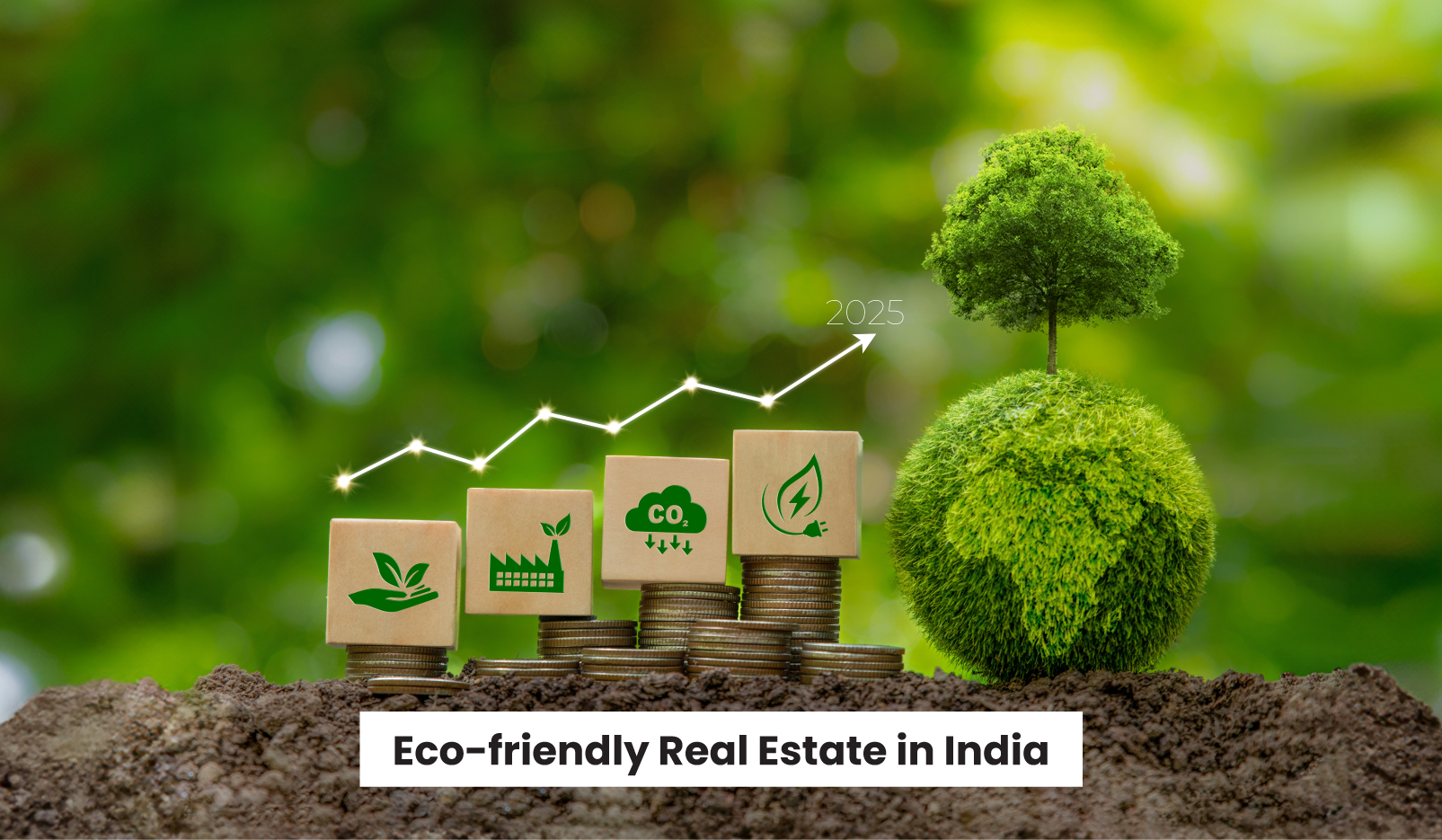
India is rapidly experiencing urbanization due to which it may raise pivotal concerns pertaining to ecology and when it comes to the sector of real estate developers and builders are more inclined towards reducing the carbon footprint, conserving energy, and promoting eco-friendly practices in this industry.
It establishes environmentally responsible, socially collective, and commercially feasible techniques including energy efficiency, water conservation, and lower carbon emissions, all while maintaining occupant well-being.
India has led in international findings endorsing around nine billion square feet of IGBC (Indian Green Building Council) certified regions. Green buildings in India are designed and erected to be more energy-efficient, cutting energy consumption by up to 30% and water usage by 20-30%. This movement is concurrent with India’s promise to achieving net-zero emissions by 2070, a milestone during COP26.
They integrate and include innovative design elements, sustainable materials, and advanced technologies to reduce environmental impact and enhance the quality of life for residents. By harnessing renewable energy sources like solar and wind power, they reduce dependence on fossil fuels and significantly lower carbon emissions, paving the way for a greener and more sustainable future.
What is Eco-Friendly Real estate?
Green and sustainable homes are quickly becoming the future of the real estate industry in India. They’re not just about decreasing carbon footprints—they offer a smarter, healthier, and more cost-effective way of living. By blending environmental responsibility with energy efficiency and long-term savings, these homes create thriving, sustainable communities. With more people seeking eco-friendly real estate and strong government support through policies and incentives, the green real estate sector is on the verge of a major transformation, shaping a more sustainable future for India.
Let us dive into how the real estate industry in India is experiencing a paradigm shift towards green and sustainable homes, making them the future of real estate in the country :
Reducing Carbon Footprints
One of the most crucial milestones of ecological and sustainable housing projects is to reduce the carbon footprint. Such homes possess innovative design elements and utilize renewable energy energy sources like solar power and wind energy. This results in establishing a foundation for eco-friendly real estate. By promoting a low-carbon lifestyle, these homes actively contribute to mitigating climate change.
Energy Efficiency and Cost Savings
Green homes and eco-friendly industry in India shed light on fostering energy efficiency through the merging of advanced and modern technologies. Homeowners can experience significant cost savings in the long run, as the operational costs of these houses are considerably lower compared to traditional homes.
Government Initiatives and incentives
The Indian government is conscious of the importance of green and sustainable housing and has unveiled several projects to encourage its development. The “Green Rating for Integrated Habitat Assessment” (GRIHA) and “Leadership in Energy and Environmental Design” (LEED) in the eco-friendly real estate verification have been adopted to evaluate the sustainability of buildings. These government initiatives and policies have played a vital role in driving the growth of green real estate in India. Green and sustainable homes are quickly becoming the future of real estate in India.
They’re not just about reducing carbon footprints—they offer a smarter, healthier, and more cost-effective way of living. By blending environmental responsibility with energy efficiency and long-term savings, these homes create thriving, sustainable communities. With more people seeking eco-friendly living spaces and strong government support through policies and incentives, the eco-friendly real estate sector is on the verge of a major transformation, shaping a more sustainable future for India.

Top Eco-friendly Projects in India
Now let us delve into the top eco-friendly projects In India that focus on culmination of the benchmark when it comes to sustainability and green living :
1. Godrej Green Cove, Pune
Godrej Properties has always been at the paramount of sustainable development and welfare, and Green Cove is evidence of their commitment. This project integrates eco-friendly and sustainable designs with modern living.
This modern living includes various kinds of features like a rainwater harvesting system, Solar-powered common areas, and the use of recycled and sustainable materials.
Godrej Green Cove also ensures a minimal environmental impact and application during construction and operation.
2. Tata Housing’s Amantra, Mumbai
Tata Housing’s Amantra is a shining example of Green Infrastructure situated in the heart of Mumbai, this project combines luxury and comfort with sustainability. What Makes It Sustainable and Eco-Friendly is Eco-Friendly Lighting and Appliances, Heat Absorption Reduction and LEED Gold certification.
The project is designed to provide a balance between luxury and eco-consciousness.
3. Adarsh Palm Retreat, Bangalore
It is a high-end walled community designed to provide an eco-friendly living atmosphere. This comprises Continuity Features like advanced Watering System, eco-Waste Converters and use of renewable energy sources.
4. Raheja Mindspace, Hyderabad
A commercial and industrial park developed by K Raheja Corp, housing numerous multinational corporations. This also includes Energy-efficient buildings, rainwater harvesting, and green spaces.
5. Indira Paryavaran Bhawan, New Delhi
India’s first on-site net-zero energy building, housing the Ministry of Environment, Forest and Climate Change. Solar power plant, geothermal heat exchange system, rainwater harvesting, and a five-star GRIHA rating.
What Makes Investors Bend Towards The Eco-Friendly Model?
Investors, at the centre of advancing sustainability, are pursuing environmentally responsible projects that align with their ESG (Environmental, Social, and Governance) goals. Driven by investor demand, green building construction has also grown significantly since 2010, with Bengaluru and Delhi-NCR at the lead of this transformation. More and more homebuyers are becoming aware of their impact on the environment and are actively choosing sustainability. They’re willing to invest more in homes that offer eco-friendly features and come with green certifications. This shift isn’t just about luxury—it’s about responsibility.
Conclusion
As we enter 2025, sustainable real estate projects are gradually becoming recognized across India. These sustainable real estate projects are created with a long-term vision of environmental responsibility, energy efficiency, and sustainable urban living. From comfort and luxury residential communities to multi-purpose developments, India’s real estate market is rapidly adopting greener practices that benefit both the environment and the people living in these regions.
These sustainable real estate projects set the stage for a greener, more eco-conscious future in the Indian urban horizon, pushing the limits of what’s possible when it comes to eco-friendly design and construction.
FAQs
Real estate developers use green principles to build structures that maintain environmental health through sustainable resources and minimized power usage along with pollution reduction.
Indian green homes offer combination of solar systems alongside rainwater collection methods as well as efficient devices along with eco-friendly raw materials that include bamboo and recycled wood. The energy and water consumption decreases because of these built-in features.
The Indian government supports green building campaigns through its Green Rating for Integrated Habitat Assessment (GRIHA) alongside the Leadership in Energy and Environmental Design (LEED) certification programs.
Investors choose eco-certified properties because they carry higher market values together with reduced operating expenses alongside alignment with ESG criteria that makes them eligible to investors through their sustainability and profitability.

![Well, #GrowWithPropacity is here to educate you all about all things Real Estate.
Follow to stay updated in Real Estate!
[Real Estate, Construction, Real Estate Tips, Real Estate Growth, Real Estate Industry, Carpet Area, Super Area, Built Up Area, Home Buying Tips, Home Buyers, Property]](https://propacity.com/blogs/wp-content/plugins/instagram-feed/img/placeholder.png)
Leave a Reply